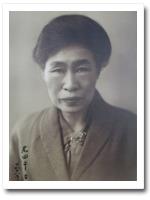
 Chika Kuroda, Japan's first woman bachelor of science, left a record of achievements in the field of chemistry.
Chika Kuroda, Japan's first woman bachelor of science, left a record of achievements in the field of chemistry.
Kuroda was born in Saga Prefecture in 1884. Born to a progressive father, she graduated from the Women’s Department of Saga Normal School and worked as a teacher there for the mandatory one year. She then entered the Division of Science at Women’s Higher Normal School in Tokyo, which was the highest level for women at the time. Her reason for choosing the subject of science was because she concluded she’d only be able to conduct lab experiments at school. By the time she graduated she had developed an interest in chemistry and wished to move on to a higher level of scholarship. The Imperial Universities, however, did not open their doors to women until 1913, when Tohoku Imperial University decided to accept its first women students.
Kuroda’s encounter with Professor Riko Majima at Tohoku Imperial University had a great impact on her career as a chemist. Her greatest interest was in organic chemistry, Professor Majima’s specialty, and she conducted her graduation research under his guidance. When she expressed her desire to research natural pigment structures, he gave her the theme of researching the structure of Tyrian purple, a pigment found in the purple gromwell plant. This was the beginning of Kuroda’s lifetime work on natural pigments. She first had to learn the importance and difficulties of obtaining crystals when researching natural substances. She conducted her research on structures of pure pigment crystals with great effort and passion. In 1918 she presented a paper on the structure of a pigment she named Shikonin, and made an oral presentation at the Tokyo Chemical Society. This was the first presentation by a woman bachelor of science, and it is said that Japanese society made a big fuss. She went on to study in the UK for two years from 1921, as an international student sent by the Ministry of Education. After returning to Japan, she worked as a professor at Women’s Higher Normal School, and also conducted research on the pigment structure of safflower, a beautiful color used by many women for cosmetics, at the Majima Laboratory of the newly established Riken. After five years of research, in 1929, she discovered the structure of carthamin, and with this paper earned a doctorate of science, the second woman in Japan to do so after Kono Yasui.
Kuroda was blessed with many wonderful teachers. She always treasured the words given her by Professor Nagayoshi Nagai when taking the examinations for Tohoku Imperial University: "Chemistry is a science of substances, so you must be familiar with substances." The history of her devotion and glorious achievements still continues to offer unspoken guidance to following generations. She donated the celebratory money received at her retirement ceremony to the school as part of the "Yasui-Kuroda Scholarship," which continues to encourage young researchers to this day.
History
| 1884 | March 24, born in Saga Prefecture, Kyushu island |
| 1901 | Graduates from Women’s Department of Saga Normal School, works at the elementary school for one year |
| 1902 | Enters the Division of Science, Women’s Higher Normal School (age 18) |
| 1906 | Graduates from the Division of Science, Women’s Higher Normal School (Photos[1] Photos[2]). Becomes a teacher at Fukui Normal School |
| 1907 | Enters the graduate course of Women’s Higher Normal School (age 23) |
| 1909 | Completes the graduate course of Women’s Higher Normal School. Becomes assistant professor at Tokyo Women’s Higher Normal School |
| 1913 | Enters the Chemistry Department of the College of Science, Tohoku Imperial University, as one of Japan’s first female Imperial University students (age 29) |
| 1916 | Begins research on the pigment of the purple gromwell plant, under Professor Riko Majima. [September] Graduates from the College of Science, Tohoku Imperial University |
| 1918 | [September] Becomes a professor at Tokyo Women’s Higher Normal School. [November] Presents her paper, "On the Colouring Matter of Lithospermum Erythrorhizon (purple gromwell)," at the Tokyo Chemical Society |
| 1921 | Researches derivatives of phthalonic acid under professor W. H. Perkin at Oxford University, UK |
| 1923 | [August] Returns to Japan via the US. Returns to Tokyo Women’s Higher Normal School as a professor |
| 1924 | Commissioned by Riken (Majima Laboratory) to research the structure of safflower pigment |
| 1929 | Receives Doctorate in science; doctoral thesis, "The Constitution of Carthamin (safflower pigment)." Becomes the second Japanese female doctor of science, after Kono Yasui. Begins research on pigments in the Asiatic dayflower, eggplant skin, black bean skin red shiso leaves, etc. |
| 1936 | Receives the first Majima Award from the Chemical Society of Japan (age 52) |
| 1938 | Begins research on derivatives of Naphthoquinone |
| 1939 | Begins research on pigments in sea urchin thorns (Naphthoquinone related) |
| 1949 | At the establishment of Ochanomizu University, becomes a professor at the same (age 65). Succeeds in extracting quercetin crystals from onion skin. Creates "Quercetin C ," a medicine for treating high blood pressure. |
| 1952 | Retires from Ochanomizu University. Becomes professor emeritus (age 68) and works as part-time lecturer until 1963 |
| 1959 | Receives a Medal with Purple Ribbon (age 75) |
| 1965 | Receives the Order of the Precious Crown of the Third Class (age 81) |
| 1967 | Has heart troubles from January |
| 1968 | November 8, passes away in Fukuoka at the age of 84 |
Catalog of Material
List of Academic Papers
Chika Kuroda List of Academic Papers
関連ファイル / Related Files
PDFファイルの閲覧には、Adobe Acrobat Reader DC(新しいウインドウが開き、お茶の水女子大学のサイトを離れます)が必要です。
 list_kuroda(PDF形式 180キロバイト)
list_kuroda(PDF形式 180キロバイト)